
Edition 133 - August 2011

Photographs by: Judie Weedon
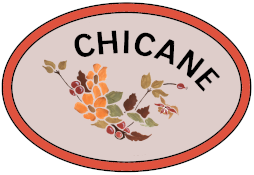
EDITORIAL
Another predicted BBQ summer - I don't think so! After a really fantastic April and spring, the weather has been unseasonal and this year even in advance of the schools breaking up - enough said!
However, most village events have managed to go ahead. Holding it earlier this year than usual, the day of the annual School Fete was grim, but the sun came out just in time to save the day, but on the day of the Village Open Gardens it rained and continued to rain without stopping all day ... a washout. 'Sitting in' at Tower Cottage we saw just eight visitors including an intrepid couple who had swum over from Swimbridge!
Now its fingers crossed for all the coming events planned for outdoors.
As you will see from the Report, our Parish Council is anxious to recruit some new members, so please give some serious thought to becoming a Councillor and helping our village in this way. Sue Squire, the Parish Clerk, would be only too happy to give you more information about what the commitment entails.
There have been some home movements of late and we wish everyone happiness in their new homes, here or away. And for those in the village not feeling at their best, we send get well soon wishes.
The Newsletter continues into another year thanks to the contributors - the regulars, the artists, the advertisers and the 'one-offers who all make editing a pleasure.
Keep up the good work! Items for the next Newsletter, October [can it really be that time again!], will be required by MONDAY, 12TH SEPTEMBER at the latest please - a few days earlier than usual.
Enjoy all the coming events and the rest of the summer.
Judie - Ed
1

WEATHER OR NOT
The weather in April was too good to last and May was much
cooler with strong winds for much of the month, helping to hold the temperature
down. There were only six days which
topped 20 Deg C and the maximum was 21.2 Deg C - according to our records this was only
the fourth May not to reach at least 23 Deg C.
The minimum temperature at 5.7 Deg C was up on average and the wind chill of
-1 Deg C was not unusual. The wind speed
reached 28 knots on two consecutive days.
There was some welcome rain for the farmers and gardeners but with a
total for the month of only 64mm [21/2"] it was one of the dryer Mays we've
known.
June was a disappointing month altogether, cool and
showery. The Open Gardens day on the
12th unfortunately was the wettest day of the month with 20mm [13/16"] by 10.30
p.m. and a total of 22mm [7/8"] by the next morning. In total there was 104mm [41/16"] of rain in
the month which was higher than usual and made it the wettest month since
January. Although the thermometer did
hit 26.9 Deg C on the 26th, for much of the month the temperature stayed below 20 Deg C
with a minimum of 5.6 Deg C which was below average. Wind speeds reached 24 knots and there was a
wind chill of 2 Deg C.
The recorded sunshine hours for the two months were both
down - in May the average since recording the figures is 151.86 hours but this
year it was a bit below that at 147.67.
In June, however, only 164.72 hours was recorded against an average of
178.55. Last year in June 207.77 hours
were recorded.
The heatwave that we were threatened with doesn't seem to
have materialised yet . . . time will tell!
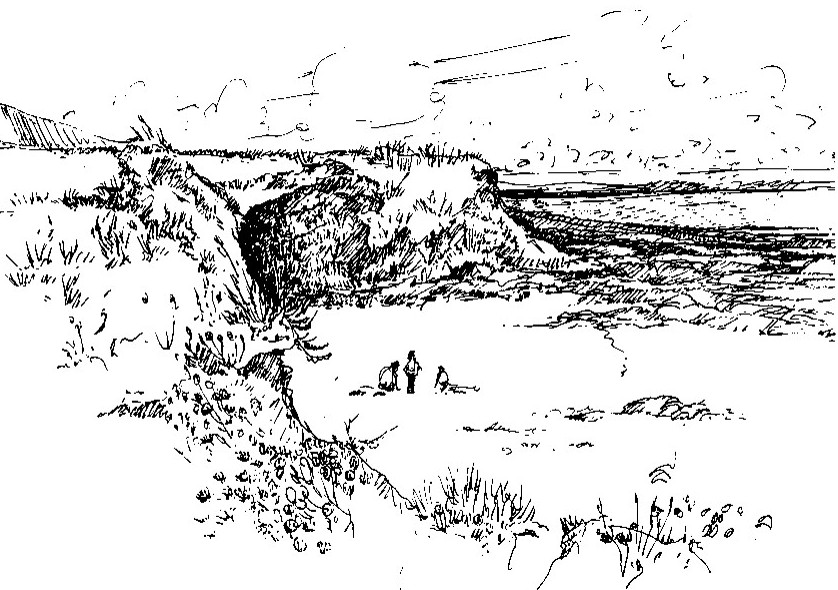
Illustration by: Peter Rothwell
Simon and Sue
2
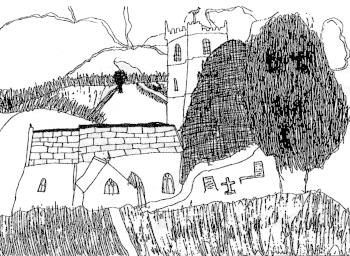
ST. PETER'S CHURCH
Our sincere thanks to everyone who handed in Gift Day
envelopes, whether at the lych gate or later on in church or to the Community
Shop. To date a generous £902 has been
raised for church funds. We enjoyed a
sunny day and it was good to have the chance to meet and talk to everyone.
On Sunday 26th June we shared an evening service with our
friends from Combe Martin. Methodist
lay reader, Martin Reardon, led the service and members of the Roman Catholic
and Baptist churches read from the Bible and led the prayers. Collections for Christian Aid were handed in
- the total has yet to be announced but the envelope collection in Berrynarbor
raised £69 plus £29.50 at the service.
By the time you read this, Christians Together will have met
here on Sunday, 31st July for a Songs of Praise evening.
Arrangements for the Summer Fayre on Tuesday 16th August at
6.30 p.m. in the Manor Hall are now in hand.
Items for the various stalls - cakes, books, toys, plants, good
bric-a-brac, china and glass - will be most welcome and again there will be a
gift stall for jewellery, cosmetics, etc.
There is a special request from Tony Summers for items for the bottle
stall, and prizes are of course needed for the raffle. Please give me a ring on [01271] 883881 if
you would like to help on the night or if anything is to be collected.
We are all looking forward to the Concert and Flower
Festival to be held in church on Saturday, 27th August - please see Stuart's
separate article.
Looking ahead, the Harvest Festival will be celebrated on
Sunday, 2nd October at 11.00 a.m. with the Evensong and Supper on Wednesday,
5th October. More information next
time.
Friendship Lunches at The Globe will be on Wednesdays 31st
August and 28th September from 12.00 noon onwards. All welcome!
Mary Tucker
3
BERRYNARBOR MUSIC CONCERT

It is nearly six years since we held a special Music Concert in St. Peter's. The church was packed and the evening enjoyed by all who attended. It is, therefore, with great pleasure that we'll be holding a similar Concert in the Church on Saturday, 27th August, starting at 7.30 p.m. Please make a note of this special event and the date in your diary.
Tickets - £5.00 for adults and £1.00 for children under 12, are available from the Shop or on the door. All proceeds will be shared between Shelterbox, Singing for the Brain and the Church Flower Fund.

In conjunction with the Concert we shall be holding a Mini Flower Festival entitled 'Composers'. The church will be open daily from Saturday, 27th to Monday, 29th August, inclusive, and you are invited to come and enjoy the floral arrangements.
We should be very grateful for donations of flowers or monies towards the cost of staging the festival. Please contact Sue Neale [883l893] or Mary Tucker [883881] for further details.
Stuart Neale
4

IN MEMORIAM
Alice Dummett
Formerly of The Retreat in the Sterridge Valley, Alice
passed away at Catherine's Court, Yelland, on the 7th June at the age of 89. Alice and her late husband, Len, were married at Combe
Martin in 1948 and moved to Elizabeth House in Berrynarbor, which they ran as
a guest house. On Len's retirement in 1969 they moved to The
Retreat.
Here they spent a happy retirement together, gardening,
walking the dog and enjoying time spent with friends and neighbours until Len
sadly died in 1998. Although well cared
for in the following years, Alice was lonely and bereft without Len.
5
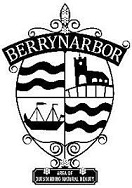
REPORT FROM THE PARISH COUNCIL
At the June Parish Council Meeting, one letter of
application had been received for co-option from Mr Gary Marshall, and he was
duly co-opted onto the Parish Council. Councillors were very sorry to
receive the resignation of Councillor Sue Sussex, both as Chairman and a
Councillor, and this is an ideal opportunity to thank her for all her hard work
and efforts while she has been a Councillor.
Currently serving as Acting Chairman is Dave Richards.
This leaves 5 vacancies still to
fill on the Parish Council. We meet on the 2nd Tuesday each month in the
Penn Curzon Room of the Manor Hall and Meetings usually end by about 9.30 p.m.
A Working Party of 3 Councillors
is formed to inspect the assets in September which involves a walk around about
an hour before the Meeting and two Councillors come to my home in late October
to work out the Budget for recommendation to the Council. If you are
interested in becoming a Councillor, please send a letter to me [e-mail will be
fine] to say you would like to be co-opted. Representations were received from
the Community Shop regarding the sewage treatment plant and Berry in Bloom.
The Accounts had been audited by Mr K Abraham, the internal auditor, and
no issues had been raised with the accounts being found in satisfactory order.
We welcomed Councillor Gary
Marshall to his first meeting in July.
There were further representations from the Community Shop regarding the
sewage treatment plant and from Judie Weedon on behalf of the Newsletter. A grant of £1,000 was agreed for the
Manor Hall and £500 for the Newsletter. If your organisation would
like to apply for a grant from the Parish Council, the criteria, laid down by the
Audit Commission and which we have to follow, is that a letter of request be
sent together with a copy of the latest set of Accounts. This has to be minuted and is
subsequently checked by the internal auditor. As it is public money
which is being donated, naturally we have to abide by the rules to ensure that
everything is open and transparent.
During the Police Report given by
PC Nic Gould, he reminded parishioners to ensure that vehicles and properties
are secured, even if only left for a short time. With more people in the
area for the summer holidays, don't give the opportunist thief an opportunity!
The Meeting was very sorry to hear
that District Councillor Mrs Julia Clark had suffered a
slight stroke and a get well card was signed by those present. I am sure
I speak for everyone when I say that we all wish her a speedy recovery and will
be glad to see her back in Combe Martin again and round
and about at meetings. Sue Squire, Parish Clerk.
Tel:
01598 710526
e-mail: wlmailhtml:
6
ORCHIDS
What a coincidence!
"Are you the Judie who edits the Berrynarbor Newsletter?" I was asked
the other day by a visitor to Arlington Court.
On replying that I was, I discovered that the family had been on holiday
here, had picked up a copy of the Newsletter and as an 'orchid fancier', Frank,
as the gentleman was called, had been particularly interested in the mention of
the Twayblade Orchid in the Rural Reflections 45 article.
Now added to the mailing list, Frank has sent the following:
We came to Wheel Farm Cottages at Berrydown in 2010 and
2011. On the second day of the first
visit we found the Community Shop and were pleased and amazed that it would
take our Times subscription coupons.
The range of goods available surprised us and seemed to have grown on
the second visit and it was a pleasure to be recognised by one of the 'Post
Ladies' when I went to collect my newspaper.
I read in the Berrynarbor Newsletter about the reappearance
of the Twayblade Orchid. We live on the
edge of 700 acres of common land managed by the National Trust, on which grow a
number of different orchids - the Common Spotted, Pyramidial, Bee, Early Purple
and several other rare ones.
Whereas you live in thousands of acres of cultivated farm
land, ours is unique in that all our roads and entrances to small estates and
houses have to have cattle grids.
On 13th May, Marking Day, between 400 and 500 heifers and
young bullocks are turned out to graze the Common until the 13th
October, by the commoners. Back in
1971, we were all given the right to apply for Commoners' Rights to graze. I think one cow, one sheep and a goat. Whilst many people apply, it is only for the
farmers who use the right. The cows
graze the grass to a reasonable height and return the wild flower seeds wrapped
in fertiliser! It is an ANOB and SSSI
[Site of Special Scientific Interest] with a difference, in that the old golf
course - we now have a new one about two miles away - which is on the Common
has the natural hazards of cows!
Cows seem to think that they came before motor cars and thus
have priority, so they cross the road when they wish and often stand with their
backside well out, so there are frequent traffic queues. Sadly, occasionally cows are killed [4 - 6 a
year], for which the National Trust carries insurance.
We like where you live but still think Minchinhampton in the
South Cotswolds is the best place to live!
We hope to visit you again next year, but we are both in our nineties,
so it is in the lap of the gods.
Frank Jamieson
8
HIMALAYAN
BALSAM or POOR MAN'S ORCHID
Although pretty, this plant is not really welcome. A large succulent annual, it was introduced
to Kew Gardens as a greenhouse plant in 1839.
It escaped to the wild and is now naturalised all over the British Isles
[and other countries] including Berrynarbor.
It is very invasive and should be removed when found.
In the same genera as
Impatiens [busy-lizzie], it is much taller and although it produces nectar and
is thought to attract pollinating insects, it suffocates other plants dying
down in winter leaving the area where it has been bare. A single plant can set about 800 seeds,
12-14 weeks after flowering. The seed
capsules react to the slightest disturbance causing the seed pods to explode
projecting seeds up to
The main aim in controlling this weed is to prevent it
setting seed. It can easily be uprooted
or cutting it at soil level should prevent it re-sprouting.
Also not welcome here in the village is another intrusive
weed, Japanese Knotweed. Imported from
Japan in the 1850's it causes many problems in residential gardens and
development sites and colonises bare land very rapidly. A more serious problem than Himalayan
Balsam, it too should be eradicated.
Methods to do this are more complicated and can be found on the internet
or from the Environment Agency or Defra.
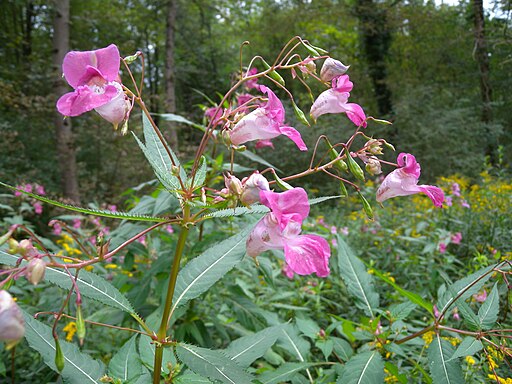
©MurielBendel
CC BY-SA 4.0, via Wikimedia Commons
9
PILATES KEEP-FIT
Classes have now finished for the summer and will resume on Wednesday, l7th September at 9.00 a.m. BUT ...
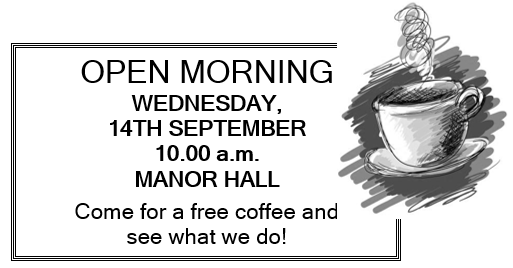
If you are not sure what Pilates is or have thought about doing a little exercising but not got round to it, do come along and watch a class whilst sipping a coffee. You will see that Pilates is a very gentle, flowing exercise and everyone works at their own pace - some more, some less! No special 'gear' is required and definitely not leotards! Just wear loose fitting clothing and sensible footwear. We'd love to see you, so do please come along [no laughing either!].
P.S. Did you see the article in the paper saying that the secret of Pippa Middleton's curves was Pilates? We can't guarantee you the derriere of the year, but you will feel as she says "fit, happy and energised."
10

11
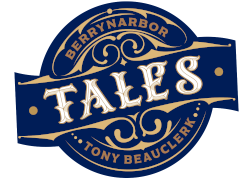
TRAPPED
Recently, I boarded a train to get to a town a few miles
away. Sitting opposite was a woman, one
of those who immediately want to get into conversation with you - and she did!
"Hello love," she said, "My name is Ruth and I'm on my way
to see my sister Mary. I've not been
well lately, what with my back playing up and the arthritis. My teeth are troubling me and I'm still
getting over the 'flu". "Have you seen the doctor?" I asked. "Oh no!" she replied, "I'm too ill to see the doctor."
"When I had the operation for my gall bladder," she
continued, "I said to the surgeon, do you know this is my first operation? He replied to me, "Now there's a
coincidence." The doctors and dentists
wear them masks you know. I think it's
so if things go wrong you won't be able to recognise them, but they don't fool
me." I nodded. "And another thing", she started, "I hate aeroplanes with
all that noise. If people want to go in
aeroplanes then the noise should be shut in with them, not annoying people on
the ground. I read somewhere in the
paper that they are going to have traffic lights for aeroplanes - I don't know
how that's going to work."

I tried not to drop off and put on a slight smile. She started again.
"What rotten weather we've been having.
My kitchen got flooded with all
that rain. No one would help, I had to do it all on my own. My neighbour is a nasty type, always
gossiping and moaning - not like me at all.
She won two thousand on the lottery and spent it all on herself. I could have done with a bit of that for my
gin cupboard. I only have a half bottle
a day, so I don't drink much."
I looked at my watch, not long to go now!
Off she went again, "These trains are so slow, reminds me of
the LNER, you know, Late and Never Early Railway. Isn't this country in a state. I hate politics so I vote for the Raving
Loony Party, I think they are the most sensible."
"My brother is in prison, you know. He did a bank job. I don't think it was very bad though as he
didn't know what to spend the money on, so gave it back to them. I'd 've given it to charity, she is my best
friend you know!"
What do you think about all this inflation? When I started work I only got 50p a
week. Now they get huge amounts and
spend it on all the wrong things.
Things are not what they used to be."
"Well", I said, "Here is my station, I must leave you
now. Keep smiling." I told her. Looking as miserable as anyone could, she replied, "I always
do, I'm not one to complain."
I alighted from the train and made for the station
cafe. Pity they didn't serve anything
stronger than a cup of tea - but I made do with that and plenty of sugar!
Illustrated by: Paul Swailes
Tony Beauclerk - Stowmarket
12


MACMILLAN CANCER SUPPORT
THE WORLD'S BIGGEST COFFEE MORNING
SATURDAY 24TH SEPTEMBER,
10.00 am to 12.00 noon
at the
Community Centre, Combe Martin
Cake Stall - Tombola - Raffle
Any donations would be very welcome, please contact
Vi Davies on 882696
13
A NUMBER RHYME
Three, four, knock at the door.
Five, six, pick up sticks,
Seven, eight, lay them straight.
Nine, ten, my fat hen.
Eleven, twelve, dig and delve.
Thirteen, fourteen, maids a-courting.
Fifteen, sixteen, maids in the kitchen.
Seventeen, eighteen, maids in waiting.
Nineteen, twenty, my plates empty.
I believe this and others, of which many have been passed down to us, were devised as home-made entertainment to help the otherwise dreary, long winter evenings. They would have been handed down from one generation to the next and even, perhaps, carried over the Atlantic by the early settlers. For example, 'Ten Little Indians' was probably an adaptation to suit conditions over there. Compare 'Ten Green Bottles'. Some, though not the above, as far as I know, were sung to traditional tunes, e.g. "Old John Braddelum" or 'Michael Finnegan'.
Trev
14
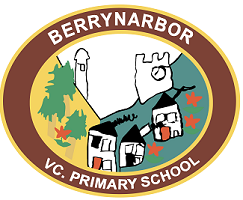
NEWS FROM
THE PRIMARY SCHOOL
How
time goes so quickly! At the time of
you reading this the children will have already broken up for their summer
holidays. Our final 7 weeks of term
have been very busy.

Some of Fagin's Boys from the recent school production of 'Oliver'
As
you may already be aware, the Federation between Berrynarbor and West Down will
be going ahead in September. So far this
has been a lot of planning and paperwork, but in September we can get on with
making it work for real.
The
whole school took part in an enterprise afternoon where pupils were divided into groups and had to come up
with a money making idea. The children
had to think of everything from expenses, how much to charge their customers,
risk assessments and advertising. It
proved very successful and they learnt a lot.
Thank you to everyone who turned up on the afternoon to support the
children and to Miss Muffet's who facilitated the car wash enterprise.
Both
Class 3 and Class 4's residential trips were very successful. Class 4 had beautiful weather all week and a
good time was had by all. Class 3 didn't
have such good weather but all the children still had a fabulous time.
Despite
a day of heavy rain, the sun shone at the right time for our Annual School
Fete. We had a successful evening and
managed to raise approximately £1300 for
our PTA. Thank you to everyone who
helped in setting up on the day and running stalls in the evening.
We are
saying 'goodbye' to our Year 6 pupils who will be moving on to their secondary
schools. We wish them every success at
their new schools.
We
are also saying a very emotional 'goodbye' to Mrs Newell who is leaving us at
the end of the summer term. She has
been with the school for over 20 years and will be very sadly missed. We all wish her well in her retirement . . .
enjoy!
We
wish everyone a safe and enjoyable summer holiday.
Sue Carey
- Headteacher

Reproduced by kind permission of Tempest Photography
15
CANINE PARTNERS - OUR ADOPTED PUPPIES
Our original puppy, Ruby, has graduated! She tells us:
"I have met my new partner,
Gary, and spent two weeks with him on our residential training course. Gary has an auto neurological
condition. Although I am now fully
trained and know all the tasks I need to know, this course is so that Gary and
I get used to each other and find out how we both work. I have to show him the ropes, really, and
help him to learn what each command means and what my response is.

The best bit of the two weeks is after the hard work of the
day's training is over, we can relax together and really start to bond. As you know, I am a very tactile girl and it
was important for me to be matched to someone who enjoys stroking a gorgeous
Labrador. Well, it turns out that Gary
loves cuddles as much as I do! In fact,
from the first day we worked together we fell in love. I am so keen to do all I can for Gary that I
quite happily walk beside his wheelchair and am totally oblivious to anything
around me. The trainers are delighted
as they say that Gary's calm manner has brought out the best in me.
For my part, I know I have already helped to build Gary's
confidence during the course and showed him all the tasks I want to do for
him. He was so impressed that he took
me for lots of walks and . . . joy of joy . . . is happy to throw a tennis ball
for me for hours! I think you can
safely say we are a perfect match.
At the end of the two weeks, it was time for me to say goodbye
to Laura and all the trainers and for Gary and me to go home and start our new
life together. I know that I
am going to change Gary's life and help him be more independent. He is already talking about introducing me
to his mates at the furniture restorer charity where he works. More people to be impressed by me and a
great opportunity to spread the word about Canine Partners as I wear my very
beautiful purple jacket!
I really hope you are proud of me - I could not have achieved this without
your support. Thank you for helping me
to make this journey."

Ruby
Now that Ruby is fully trained and partnered, we have a new puppy to join Amelia who you met in the June issue of the newsletter. Alfred is a black Labrador cross golden retriever puppy who has just begun his new life as a trainee assistance dog. Canine Partners are now operating a new scheme and in future it will be possible to follow a puppy not only throughout their training, but in their partnered working life.
However, for us here in the village to continue to support these puppies Amelia and Alfred, and the incredible work they do, it is time for us to renew our subscriptions. So, you guessed - A Coffee Morning!

Amelia on her hols!
16

Please do come and support this very worthwhile cause. Thank you.
17
QUILTING IN ALL ITS FORMS
Wednesday 31st August
You are invited to come to hear Penny Armitage from Bratton Fleming, an expert in quilting, talk and demonstrate at Ilfracombe Golf Club on Wednesday, 31st August. The evening begins at 5.00 p.m. with tea and cakes. Tickets, at £5.00, are available from Jean Pell - give her a ring on [01271] 883187.
18

RURAL REFLECTIONS - 50
The old yew tree stands at the western
end of the churchyard. Its disfigured,
purplish-brown trunk displays a colossal girth from which, only ten feet from
the ground, it splits into three immense branches. Each one immediately arches so that their off
shoots create a broad and heavily shaded canopy. The tree's trunk has a very strong outer
casing which is the sole support for the wealth of branches above, for its
innards have been devoured as has a portion of its bark, spawning a natural doorway
through which the human visitor can enter.
This yew is more than just old. It has gained immortal status. It was around when the Celts decorated its
branches with the heads of their victims; and then observed their descendants
convert to Christianity. They built a
church to keep the tree company and made it a symbol of their new found
faith. Continually outliving subsequent
generations, the tree represented eternal life whilst its poisonous berries and
strong wood, from which spears, arrows and bows were made, represented death.

Illustration by: Debbie Rigler Cook
Whilst the yew was relieved
when its wood was no longer used for warfare, it was dismayed that this was
only because more effective forms of weaponry had been developed. The tree was itself hit by a cannonball when
the church, protecting Royalists inside, was attacked by Parliamentarians. Ironic that the ball should be discovered by
a young man who in 1915 was sitting inside its now hollow trunk, creating a
personal poem about peace. The old yew
now looks down upon the young poet's name - on the war memorial.
Twenty five years later
that same hollow trunk was to be a refuge for another young man's inspiration,
this time compiling a speech about the atrocities of war. The conscientious objector's words were being
written with added emotion for an enemy aircraft had dropped a bomb in the
grounds of the local Manor House the night before.
The incident was all the
talk that following Sunday. Parishioners were fearing if and indeed when the
next bomb would drop. Yet even the wise
old yew could not have predicted that seventy years on the incident would bring
indirect pleasure. For only last Sunday
two parishioners walked past the tree whilst commenting on the beautiful water
lilies on display at the Manor House Open Gardens - in the pond created by the
bomb crater.
Two other parishioners were
discussing the rare orchids recently discovered in the disused quarry, a quarry now so densely covered in
ferns it blends in with the vista. Yet
the yew can recall how previous generations had viewed it as a grotesque cleave
within the western hillside.
The yew has also presided
over the parishioners' disapproval of the eastern hillside when the landowner
planted a pinetum, starving the ground of sunlight and destroying, in their
view, the natural spring display of primroses and bluebells. The yew observed the pines being felled last month - and then listened to those same parishioners, now much older,
discussing their lovely pine furniture.
Going further back in time,
the yew can recall how villagers had fumed about the construction of a viaduct
which subsequently blocked their view down the valley; and how other local
areas were witnessing chunks of earth being sliced out and banks of earth being
created for the coming of the steam railway.
Now the yew listened to two men, one hankering for the golden age of
steam, the other looking forward to a trip on a restored steam line. The latter had an American accent, visiting
the parish in order to trace his family history. Yet the yew can recollect when "foreigners"
were people from nearby villages and towns, using the new railway to come and
sell their goods, tempting the parishioners away from home grown and home-made
produce. Village tradesmen protested
that it would be "The downfall of our local trade!" The yew has heard that said a lot down the
years.
It was not just the coming
of the train that was disapproved of.
The yew has noted how every new mode of transport has been received with
a "Tut!" - even the bike. It can
recollect one particular parishioner forecasting that it would be the end of
human conversation with villagers now no longer stopping to talk, rather just
pedalling on and replacing the polite "Hello" with a discourteous ring of the
bell.
In fact the tree has
eavesdropped on many a discussion about just that, the dying art of
conversation. Only last Sunday it
presided over a mother remarking how computers were encouraging her children to
talk via a 'square screen' and stay indoors, yet the tree can remember when her mother was aghast at the onset of
Children's TV, encouraging her daughter to develop 'square eyes'. Further back in time the yew can recall
overhearing a mother's disapproval of the radio which had come into her home
for her children were no longer going outside to listen to the music being played
in the village square.
The yew could also recall the
parishioner who refused to buy an electrical radio in protest at the monstrous
pylons that had been put up which had, in his view, eternally devastated the
rural view. However, only last Sunday the yew heard the same
sentiments expressed about another source of energy, this time taking the form
of gigantic windmills, that had been erected locally . . . yet the pylons had
not been spoken about for decades.
Steve
McCarthy
19

NEWS FROM OUR COMMUNITY SHOP AND
POST OFFICE
Prices are down! If you've not seen Deb's photo in the
Journal [14/7/11] nor read Fenella's Community News, if you've not enlisted for
the e-mail shot nor visited the shop recently to see the placard, MILK is now
cheaper than you know which local supermarket due to careful marketing and as a
thank you to our loyal customers. So,
in Fenella's words 'pick up a pint, or lift up a litre!'
The 7th AGM took place at the end of
June. The main points were that last
year was not so good for trade; neither were the first few months of this
year. But, whether it is thanks to
Tony's reminder in the April Newsletter or even better bargains in the shop,
our last few months have shown an improvement in sales. So please
keep up the trend - and tell your friends how good it is to shop here!
Anita and Deb are always looking for new
ideas to attract and have come across Queenswood who will market items under
our own brand. These are mainly packaged and frozen goods and will tempt you
into buying - we hope!
Don't forget that we now have a small
stock of children's outdoor and beach games - to keep everyone happy during the
long hot summer! We have had a raid on books
recently, so if you have finished with a sizzling romance or heart-stopping
thriller, do please donate it to the shop. The same goes for plants. These sell
very well, and if you've bought any, you will know how well they grow.
August 20th needs to be written large in
your diaries! After the Horticultural
and Craft Show in the afternoon, a Jazz Concert will be held at Sloley Farm in
the evening - proceeds to our Shop and other village activities. It should be a great evening with food and
drink on a 'bring your own' basis, but pudding refreshments will be provided
free. Tickets at £10 per person are on sale in the Shop. Get yours now for a fantastic evening!
Finally, if you are off to foreign parts
this summer, don't forget that Euros are always kept at our Post Office - no
need to order in advance.
Here's to a pleasant summer and happy
Berrynarbor buying.
PP
of DC
20
HEALTH MESSAGE
If walking/cycling/running is good for your health, our postman would be immortal.
A whale swims all day, only eats fish, drinks water and is fat. A rabbit runs and hops and only lives 15 years. A tortoise doesn't run, does nothing ... yet lives for 450 years
... and you tell me to exercise!

21
LOCAL WALK - 127
Good Day at Blackchurch Rock
I'd had a distant glimpse of Blackchurch Rock from out at
sea on board a heaving and rolling Balmoral.
I'd seen photographs of it in books and was intrigued by this strange
and unusual rock formation. It is a dark pyramid at the eastern end of remote Mouthmill
Beach, west of Clovelly, punctuated by two large pointed holes which resemble
Gothic windows.

Illustration by: Paul Swailes
In a recent article in the North Devon Journal, in which
people were asked what were their favourite places along the North Devon coast, Dave Edgecombe, Project
Officer for the Area of outstanding Natural Beauty, chose Mouthmill Beach which
he described as 'a real hidden gem ... far from the madding
crowd.' His family had spent '...
many a happy hour whiling away the day there.'
We started our walk from the National Trust car park at
Brownsham, a small hamlet reached by a maze of lanes from the Hartland road.
A broad track through a wooded combe leads eventually to the
beach. The Sitka Spruce and Douglas Fir
make this a rather gloomy trek but the monotony was relieved by the wild
flowers; Enchanter's Nightshade and
Yellow Pimpernel with, in the damper areas, Brooklime and Hemlock Water Dropwort. The needles of Douglas Fir have the scent of
oranges when crushed.

Suddenly the prospect opened out and there was the beach
composed of rocks, pebbles and boulders.
Mouthmill is a lonely atmospheric cove with its disused quay and large
lime kiln with the remains of two derelict cottages behind it.
There is a view of Lundy and across Bideford Bay to Baggy
and Morte Points. We picked our way
carefully over the rocky shore to reach Blackchurch Rock. It did not disappoint. It loomed above us suitably sombre and
mysterious.
The poet and radical Charles Kingsley, author of The Water
Babies and Westward Ho! lived nearby when he was a boy. His father was the Rector of Clovelly.
In 1849 Kingsley described Mouthmill: 'A deep crack in wooded hills; an old mill half buried in rocks and flowers
over which wild boys and bare-footed girls were driving their ponies with
panniers full of sand and as they rattled back to the beach for a fresh load,
standing upright on the back of their steeds, with one foot in each pannier, at
full trot over rocks and stones where a landsman would find it difficult to
walk.' [The particles of shell in the
sand being used to neutralise acid soils.]
Hard nowadays to picture this quiet place the scene of such
activity.

Images: Blackchurch Rock from the Tom
Bartlett Postcard Collection - c1911
Sue H
22
MARWOOD HILL GARDENS
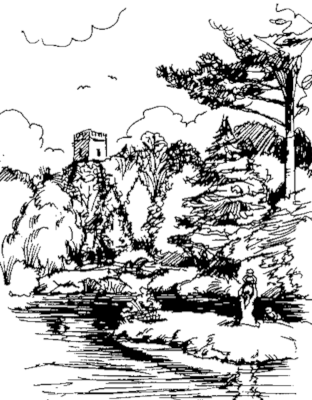
Begun in the 1950's by an inspired gardener, many locals still refer to the gardens as Dr. Smart's Garden. But since his death in 2002 when they passed to his nephew, they have had to earn their keep! To this end, there is now a thriving Plant Centre with trees, shrubs and plants for sale at exceptionally reasonable prices, and a flourishing Garden Tea Room serving morning coffees, light lunches and cream teas, with a selection of delicious cakes available throughout the day.
Open from 10.00 a.m. to 5.00 p.m. daily [last orders for the Tea Room at 4.30 p.m.] with entry at only £5.50 - or you could do even better with a 12 month season ticket for just £22.50.
Why not come and wander around the colourful plant displays and lakes with their wildlife and keep Dr.Smart's vision alive?
Illustration by: Debbie Rigler Cook
23

BERRYNARBOR HORTICULTURAL & CRAFT SHOW 2011
We hope that you are all busy getting your entries ready for the Show on Saturday 20th August, and we are really looking forward to seeing your fantastic displays.
Schedules are now available from the Community Shop, The Globe and Sawmill Inn and Sue's of Combe Martin.
Just a quick reminder that if you have not already done so, all cups should be returned to Linda Camplin, Barton Hill, Berrynarbor, as soon as possible.
We look forward to seeing you on the 20th!
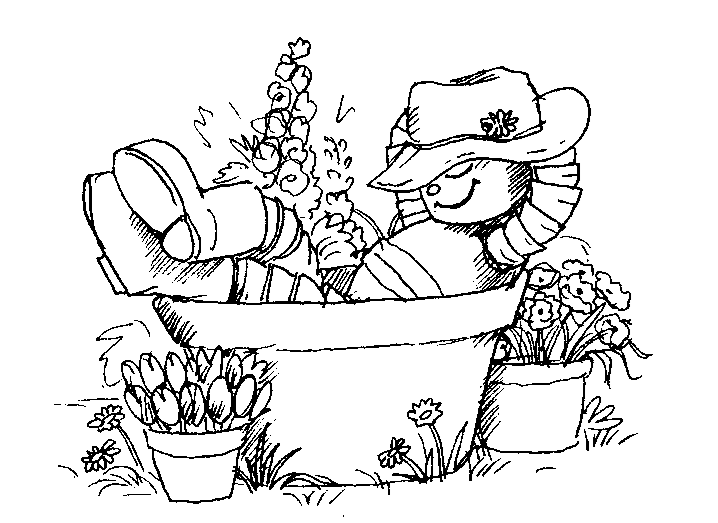
The Committee
24
DEVON COUNTY COUNCIL
Look Out for Our Autumn 2011 Brochure!
We are offering lots of courses and training opportunities in your local area at the Two Lanes Centre in Ilfracombe.
| Course | Date | Time | Cost | Venue |
|---|---|---|---|---|
| Flower Arranging - Beginners | 20 Sept | 13:00 - 16:00 | £68 | Two Lanes Centre Ilfracombe |
| Computing - UK Online Basics | 19 Sept | 12:00 - 15:00 | Free | Two Lanes Centre Ilfracombe |
| Digital Photography - Beginners | 22 Sept | 13:00 - 15:00 | £109* | Two Lanes Centre Ilfracombe |
| Spanish - Absolute Beginners | 19 Sept | 19:00 - 21:00 | £44* | Two Lanes Centre Ilfracombe |
* Concession may be available.
Please contact Devon Adult & Community Learning on [01271] 864171 for more information or to book your place now!
Or, look at all courses online www.devon.gov.uk/adultlearning.
25
WALTER'S WHISPERS
He
Built His House on Sand
Down on the beach, amongst the sand dunes of Bude, in
Cornwall, is Bude Castle, a remarkable building that was the world's first
permanent structure to be built on shifting sands.
It was put up in 1830 by Sir
Goldsworthy Gurney [1793-1875], who overcame the problem of instability by
laying a strong concrete platform directly on to the sand for the foundations,
thereby inventing a building technique widely used in the modern construction
industry. Thanks to this ingenious
Cornish inventor, engineers knew how to build the world's tallest building, the
Petronas Towers at Kuala Lumpur, Malaysia, on soft, wet limestone.
.jpg)
Barbara Bush
©John Mathew Smith & www.celebrity-photos.com
from Laurel Maryland, USA
CC BY-SA 2.0, via Wikimedia Commons
He
Took A Second Look
A friend of mine told me about something he spotted on the
staff notice board at a works he visited a short time ago. He had to take another look as he couldn't believe what he
was reading. It was fortunate he took
that second look. At first the notice
appeared to be instructions to the staff to: grumble,
criticise,
blame,
complain,
gossip and
think negative.
Then my friend caught sight of a single word at the top of
the notice - Don't!
Our
Time
Bankers and financial experts may offer us lots of
advice. However, all the experts in the
world seldom tell us how to spend one item that is more important than
money. I call it 'our time'.
This invisible currency is the most important thing we can
spend or save, and the wise person will put family concerns high in his or her
time-spending priorities, as Barbara Bush, a former First Lady of the United
States, advised. "At the end of your
life," she said, "You will never have regrets at not having passed one more
test, not winning one more verdict, or not closing one more deal. But you will regret any moments of time that
you have failed to spend with a husband, a friend, a child, or a parent."
We
Need Space
In the busy rush of modern
life it is often difficult to find time to be alone and to be still. Blaise Pascal said that all
the troubles of life come upon us because we do not sit quietly for a while
each day. Thoreau loved being alone, saying he 'had never found the
companion that was as companionable as solitude'. Another philosopher said that solitude is to
the mind what diet is to the body.
Of course we all love our family and friends and good
company, but we also need time to ourselves, 'space' as we might call it today.
Walter
26
MOVERS AND SHAKERS - NO. 34
HOPE LILIAN BOURNE
[August 26 1918* - 22 August 2010]
Author, Artist and individualist
* Hope
Bourne claimed to have lost her birth certificate. The Exmoor Society guessed that she was born
in 1920. Her obituary gives the above date.
It must take a lot of 'Moving and Shaking'
to have one's obituary in the Daily Telegraph, yet a year ago, Hope Bourne achieved this accolade.

By kind permission of Chris Chapman
©www.chrischapmanphotography.co.uk
No doubt you have heard of her and may
have read her four books about her beloved Exmoor: Living on Exmoor [1963],
A Little History of Exmoor [1968], Wild Harvest [1978] and My Moorland Year
[1993]. You may have followed, in
the early 1970's, her 1,000 word weekly articles in the West Somerset Free
Press. To fulfil this, every Friday she
walked 3 1/2
miles into Withypool to collect her newspaper, bread and post, and to mail the
next week's article. Then again, you may
have read her contributions to The Exmoor Review! All her writings were in pencil, many of
them illustrated by her own pen and ink drawings. She was also the subject of
two TV documentaries: About Britain: Hope Bourne Alone on Exmoor [1978] and
Hope Bourne - Woman of Exmoor [1981].
How did she find the time to
achieve all this, bearing in mind that for over twenty years in the 1970's -
90's she was being self-sufficient in a leaky caravan on a derelict farm at
Ferny Ball, about 4 miles from Withypool?
As she put it: "It's a good life,
but it's a tough life. You've got to be 100% physically fit to live as I do."
Can you imagine being marooned in this
caravan during a 48-hour blizzard in the 1970's with flakes of snow drifting
through the leaks? As she later
recalled, 'At intervals I ventured out to clear snow away from the area around
my door . . or I would be trapped. I did not go to sleep until I was sure the
snow would not drift too high against the door before I woke again'. She also dug waist deep into snow to save 76
pregnant ewes and 20 head of cattle.
Hope lived a simple life. Her home was only 14' x 6'. It had 3 bunks, two of which she filled with
books and slept on the third. The
caravan was festooned with the skins, hooves and antlers of animals she had
shot, gutted and eaten. She possessed an
American .22 rifle and a 12-bore shotgun and with these she shot wood pigeons,
deer, rabbit or hare. She also fished,
gathered her own fuel, grew vegetables and kept bantams, but no dog, saying,
"My meat supply is so irregular that it couldn't feed a dog. I can pull in my belt and live on potatoes
when things get bad, but I couldn't expect that of a dog, and I couldn't afford
to pay for pet food."
When times were good, she reckoned to eat
about a pound of meat daily, some of which was none too fresh! Household chores were simple. A huge
breakfast of meat and vegetables was cooked in, and eaten from, a frying
pan. She had 3 mugs: one for tea, one
for coffee and one for lemonade or water - so there was no washing up! Drinking water was from a nearby stream. I remember reading some years ago that she
never washed vegetables - just cooked them straight from the ground, soil and
all.
So apart from her writings, how did she
support herself? Well, she helped
farming friends in busy times, with lambing and winter feeding. In the 1950's-60's, her income was about £100
per year. She reckoned to save half of this, living on £5 a month, which was
mainly spent on cartridges.
Nevertheless, she had many friends and claimed to send out about 100
Christmas cards each year. Whilst
wandering Exmoor, she would call in on friends and they would return her
call. Also if she was in difficulties,
she could always rely on some of them to help.
She did not spend her whole life on
Exmoor. In the 1950's she enjoyed a
year on a sheep farm in Australia and in the '70's stayed for three months with
friends in Canada.
Hope Bourne was born in Oxford, but whilst
young moved to Hartland where her widowed mother became the headmistress of
Elmscott village school. She left school
aged 14. An asthma sufferer, she lived
with her mother, first in Devon and then from 1939 in the Cotswolds. Here she
worked on the land, but missed Devon.
When her mother died when Hope was in her 30's, she had to sell off the
house to pay off debts and was left no home, few assets and no qualifications
for working normally. So she returned to her first love - Exmoor.

Hope Bourne sketching on Exmoor
By kind permission of Chris Chapman
©www.chrischapmanphotography.co.uk
Here she decided to become
self-sufficient. She would get up at 5.00
a.m., write up her diary and then walk
up to 20 miles a day, sketching or hunting for food. She never carried a map, trusting her 'homing
instinct' if she got lost.
By the late '80's, friends persuaded her
to have a telephone for emergencies, and then, as her asthma worsened, to move
into a house in a community scheme in Withypool. Here she made little use of modern
conveniences: she rarely used
the electricity, never the central heating, slept on the floor of the living
room in front of the open fire, and let her bantams use the rest of the
house! She sold her guns and so had to
buy meat from the local butcher and felt she had moved to a city where as she
described them, 'Everyone looks so miserable!'
She loved Exmoor and felt that National
Trust and National Parks hadn't always done the best for it - mainly by putting
footpath signs everywhere and taking the responsibility away from people to
think for themselves.
She once said, "I'm bloody-minded. My
independence is the most important thing in the world to me: freedom and a
vigorous outdoor life".
She was a remarkable lady who lived up to
her beliefs. I'm afraid she wouldn't
have approved of me - when on Exmoor, I like those footpath signs - and a map!
PP of DC
27

BERRY IN BLOOM & BEST KEPT
VILLAGE
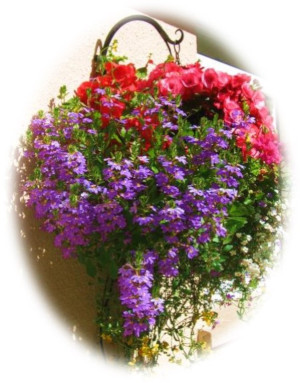
I hope you all agree that, as we approach
judging time, the village is looking
lovely. We have pushed out the boat a
bit this year and spent the money we
have raised on beautiful flower displays as we are representing the South West
in the National R.H.S. Britain in Bloom competition. We are lucky that so many villagers are dedicated
to help with litter picks, gardening and other tasks in trying to achieve the
goal of champions.
We have applied for a grant from Anglian
Windows who are sponsoring this year's competition and have been given
£250. Our intention is to buy a new bench
and table to go in the gravelled area next to the Shop/Post Office so people
can bide a while and maybe enjoy an ice cream.
The shop helpers must be very pleased that a watering system has been
installed to save them the difficult and soggy job of watering the hanging
baskets - thank you, Ken.
Ken has also installed a watering system
in the centre of the village and again this is an absolute boon to the
hard-pressed wielders of the longest hosepipe in the west.
Our plans to renovate the area to the
right of the bus shelter at the bottom of Pitt hill will hopefully come to
fruition but not before the judging. It
will have to be a work in progress. We
have been very fortunate to be given a donation by the firm of one of our
villagers to complete this work and our thanks go to Geoff and Judith.
The two Open Garden dates have come and
gone; the first a complete washout as we had persistent heavy rain with strong
winds and only sold six tickets!
However, the Sterridge Valley afternoon was lovely and was well
attended, with Judie's team providing the visitors with wonderful teas as
usual. Many thanks to all who helped
and Phil and Lynn for hosting the B.B.Q. for Berry in Bloomers in the evening.
We have done our best and now await the
judge's results!
Wendy Applegate
28

Plum and Almond Tart
This lovely moist tart can be made with
plums or apricots, just match the jam to the fruit and it can be served warm as
a dessert or just as a slice with a cup of tea.
Sweet dessert pastry, your own recipe or (I often cheat and use Sainsbury's fresh dessert pastry!!)
- 6oz/150g unsalted butter or margarine
- 6oz/150g ground almonds
- A few drops of almond essence
- Punnet of plums or apricots
- Almond flakes
- 6oz/150g golden caster sugar
- 2oz/50g plain flour
- 2 medium free-range eggs
- apricot jam
Make the frangipane by creaming
together the butter and caster sugar until light and fluffy. Beat in the eggs, flour and the ground
almonds with a few drops of almond essence.
Roll
out the pastry and line a fairly deep 9 inch flan dish. Crimp round the top and then spread a layer
of jam on to the pastry being careful not to tear the pastry. Spread the frangipane over the jam - it
should come almost to the top. Next cut
the plums or apricots in half and remove the stones, arrange over the frangipane
cut side down. Scatter the top with
flaked almonds and dust with icing sugar.
Bake at 180 Deg C/350 Deg F for about 45
minutes. Test to see if the flan is
cooked - the fruit should be soft but the frangipane will still be moist.
Of course you can use plums from the
garden or greengages would be lovely, experiment and enjoy.
Wendy Applegate
29
THANK YOU
Ron would like to thank everyone
for coming to his 95th Birthday at Lee Lodge and for the many wonderful cards
and presents he received. He was
delighted that his daughter Sheila and her husband Tony were there to help him
celebrate his special day.
His biggest thank you goes to Shane
and all the staff at Lee Lodge not only for the wonderful spread and cake
provided for his guests, but also for the wonderful care they take of him - he
is very happy and at home with them all.
30
CHARITY CYCLE RIDE

Our journey to John O'Groats to begin our charity cycle ride
to Lands End went well, with nice weather and camping just in
Scotland on the Saturday night.
We arrived at our starting point just
after lunch time and enjoyed some bird watching and the rugged coastline,
staying up to watch the sunset.
Monday morning early and we were off! It was pouring with rain and quite windy,
and that's how it was for the rest of our time in Scotland. It was also very cold, especially over the
mountains.
We made good distance for the first half of the trip, having
the support of Pat and her campervan, which was very much appreciated. I had some problems with my lower gears, a
tent pole broke and Jo had a puncture, but otherwise there were no other real
problems although Jo suffered a very painful knee injury but she battled on for
the last 8 or 9 days. The weather
never really improved and we cycled 920 miles, averaging 50 a day.
I should like to thank everybody who donated to our cause
and who helped in other ways. So far we
have raised in excess of £1400 for CLIC, caring for children and young people
with cancer.
Malcolm [Canham]
Congratulations to Malcolm and Jo and
all their team on a great achievement.
It is not too late to support them in their efforts so if you would like
to help go on line www.virginmoneygiving.com/team/jo-gle.
31

During the week-end of 24th/25th September, the Hospice are organising four Devon Walks as a fund raising event, all varying in length and required fitness levels!
Taking it easy on Saturday, 24th at 11.00 a.m. you can walk round the lake and grounds at Arlington Court. This is a gentle, 2-mile walk. For the more ambitious there is a 7-mile walk in the evening, from 4.00 p.m., on Saunton Sands Beach. An intermediate walk followed by a BBQ whilst watching the sunset.
On Sunday, 25th, you can take a breath-taking 14-mile circular walk from Brendon Two Gates, starting out at 9.30 a.m. A challenging walk with plenty of inclines! Or, you could do the coastal walk from Clovelly to Hartland Quay. A tough, but beautiful 10-miler which starts at 10.00 a.m.
If you would like to take part in one [or more!] of these walks in memory of someone or just to help raise money for the Hospice and would like more information, please ring the Fundraising Team on [01271] 347224 or contact Judie at Chicane or on [01271] 883544.
32
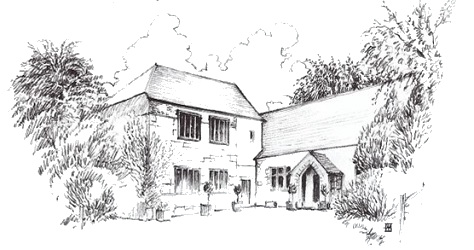
MANOR HALL MATTERS
With just a small amount of painting to do, the kitchen project should be finished by the
time you read this. To top'n'tail the project, we have sourced
some new, styling white mugs for all the tea and coffee drinkers, and for those
sitting down for a lunch or supper, there's a brand new stock of white dinner
plates to take over from the '57 Varieties' you've been living with until
now! Did you increase your own supply
of recycled dinner plates from the bric-a-brac stall at the Berry Revels?!
The Committee continues to work well and has recently been
joined by Lorna Bowden who has been co-opted to represent the Parish Council.
Looking ahead, you'll all be aware that 2012 is Olympic
Year, but did you know it will also be 65 years in February since the Manor
Hall, Manor House and Parish Room were acquired for the benefit of the
parishioners?
Could this be a theme for
organising and doing something tangible around the Hall and its facilities for
the benefit of both present and future generations of villagers? Please do let us have your thoughts and
ideas - it couldn't be easier than writing in the new comments book we've set
up and located on the kitchen shelf!
Colin [889298] - Chairman
33

34
ABOUT KEEPING GOATS!

Perhaps
it was because we were both capricornians that goats came into our lives. At least, they entered my husband's life, and
consequently affected mine.
After 26 years wandering around the world in
the RAF, a settled existence in the Devon countryside and the acquisition of a
house with adequate land, gave my usually practical husband ideas of 'The Good
Life', and a bit of self-sufficiency.
Livestock
were studied in detail and the library raided for books. We soon had chickens, geese, ducks, a cat and
a dog, and a couple of bee hives [which we'd kept in a previous location]. The decision was then made that 'goats were
just the animals for us'.
I had visions of our wilderness being
grazed into a luscious meadow, so uttered agreeable sounds which indicated that
divorce would not ensue if he went ahead with the plan.
We soon became familiar with the
language and with the breeds of Anglo-Nubian, Saanan, British Alpines and
Toggenburgs. Milk yields were studied,
daily feeds and stabling were appraised and we felt the urge to go ahead!
The stabling proved easier than
anticipated. A winter storm had swept
the West Country that year and had caused our garden shed to take off and fly,
section by section, across the land . . . bit like The Wizard of Oz, but more
frightening! The Insurance Company gave
us their condolences and a cheque, which nearly covered the cost of the goat
shed.
The
next stage was to buy a goat. The local
papers were scoured and a suitable 4 month old nanny goat was found. We travelled out into the countryside to see
her. We heard her before she came into
sight. A pitiful continuous bleating
led us to a very moth-eaten, miserable goat tethered in an unkempt garden with
a piece of string. Her ears were
jagged, as though bitten by some insects, her hooves overgrown, as they had not
been pared back, and her coat looked more like a moth-eaten rug. Not the world's most attractive animal. We felt like criminals as we announced that
we would 'think about it', and returned home.
The
library books stated clearly, 'Never buy a goat because you feel sorry
for it'. So we hurried back to pay the
cash, and bring her home.
The
new shed must have seemed like a palace to Lucy - as we now called her. Fed on the best concentrates, brushed, feet
pared and given affection, she thrived.
After
a few months, and more library books, we realised that Lucy needed
company. She was not old enough to have
a kid, so we decided to get a second goat - preferably an expectant mum.
We
purchased Heidi off a sweet old gentleman, and were assured that she was in
kid. She was not the gentle blonde baby
that Lucy was - she was black, with horns that had been cut off and a white
star on her forehead. All this gave
her a slightly demonic aura. When in a
playful mood, she would rise on her back legs, before charging. She taught Lucy
some very bad habits, and Lucy loved her.
George
devised complex feeding containers in the stable and when the last nail went
in, Heidi would appraise the work, stand back and charge, reducing the work to
matchwood. The air was then strong with
curses about goats in general, and Heidi in particular. We then found that Heidi's pregnancy was a
non-event and happily a friend decided in a weak moment to buy her off us, and
she went to a good home.
In the
meantime, we had answered another advert, this time for a goat that had kidded,
and was therefore 'in milk'.
Another journey into the depths of the West Country found us surveying a
lovely goat called Sapphire, a good milker - but getting on a bit. The owner then produced Sapphire's daughter,
Silver, who had never been separated from her Mother. Being 'suckers', we then found ourselves
with two goats - both in milk.

For
some reason, my two year old car, my only means of transport, was used to bring
the two goats home. This caused some
funny looks from people, but the car got home intact - except that goats, like
children, will wait to within a hundred metres from home, before they can 'wait
no longer'. A lot of disinfectant was
needed to restore my car to any form of luxury!
Sapphire and Silver were welcomed by Lucy, and Sapphire accepted her as
a sister for Silver.
Now
for the milking! Instead of having one
goat to learn on, my husband found himself forced to milk two goats, twice a
day, with no previous experience. The first try took two hours. I did not know whether to feel more sorry
for George, or the goats. The yield was
five pints, and after straining and cooling, the difficulty became using it all.
When
the situation settled, and milking was easy, we found the local doctors sending
us visitors and locals whose children were allergic to cow's milk [before
Sainsburys].
We
kept goats for about six years and loved them dearly. We bred them, and they
were entered into a 'stud' book.
Our
children then had left home, and we wanted to travel - and we had moved to
Berrynarbor, so the 'self- sufficiency' of goats, geese, ducks, bees and chickens gradually went.
I
think we missed the goats most of all - very hard work, but it was a bit of
'The Good Life'!
Yvonne Davey
35
THE GAMES WE PLAY!
Starting in 1941, an increasing number of British airmen
found themselves as involuntary guests of the Third Reich, and the authorities
were casting about for ways and means to facilitate their escape.
Obviously, one of the most useful aids is an accurate map,
one showing not only identification points but also the locations of 'safe
houses', where they would be made welcome.
Paper maps had drawbacks - they make a lot of noise when you open and
fold them, they wear out quickly and if they get wet they turn to pulp.
Some genius in MI5 came up with the idea of printing on silk
- it's durable, can be scrunched up into a tiny pad, unfolded and folded as
many times as needed and is completely silent.
At that time there was only one manufacturer in Great Britain
that had perfected the technology of printing on silk and that was John
Waddington Ltd. When approached by the
government, they were only too happy to help with the war effort.
By coincidence, Waddington was also the UK Licensee for the
popular American board game Monopoly.
As it happened, games and pastimes was a category of item qualifying for
insertion into 'Care' packages despatched to prisoners of war by the
International Red Cross.

Under the strictest secrecy and in a guarded and inaccessible
old workshop in the grounds, a group of sworn-to-secrecy employees began mass
producing escape maps keyed to each region of Germany or Italy where Allied POW
camps were located. When processed, the
maps could be folded into such tiny bits that they would actually fit inside a
Monopoly playing piece.
The clever workmen at Waddington's also managed to add a
playing token, containing a small magnetic compass, a two-art metal file that
could be easily screwed together, and useful amounts of genuine high denomination
German, Italian and French currency hidden within the piles of Monopoly money!
British and American air-crews were advised before taking
off on their first mission on how to identify a 'rigged' Monopoly set - by
means of a tiny red dot made to look like an ordinary printing glitch located
in the corner of the Free Parking square!
Of the estimated 35,000 Allies POW's who successfully escaped, an
estimated one-third were aided by the Monopoly sets. Everyone who did, and the Waddington workers,
were sworn to indefinite secrecy since this might be needed in another, future
war.
The story was de-classified in 2007 when the surviving
craftsmen from Waddington's, as well as the firm itself, were finally honoured
in a public ceremony.
How nice to be able to play that 'Get Out of Jail Free'
card!
36
THE HUNTING OF ARSCOTT AT TETCOTT
In the month of November, in the year fifty-two,
Three jolly Fox-hunters, all sons of the Blue,
Came o'er from Pencarrow, not fearing a wet coat,
To take their diversion with Arscott of Tetcott.
The daylight was dawning, right radiant the morn
When Arscott of Tetcott he winded his horn;
He blew such a flourish, so loud in the hall,
The rafters resounded, and danced to the call.
In the kitchen the servants, in kennel the hounds,
In the stable the horses were roused by the sounds,
On Black-Bird in saddle sat Arscott, "To-day
I will show you good sport; lads, hark, follow, away!"
They tried in the coppice, from Becket to Thorn,
There were Ringwood and Rally, and Princess and Scorn;
Then out bounded Reynard, away they all went,
With the wind in their tails, on a beautiful scent.
"Hark, Vulcan!" said Arscott, "The best of good hounds!
Heigh Venus!" he shouted, "How nimbly she bounds!
And nothing re-echoes so sweet in the valley,
As the music of Rattler, of Fill-pot, and Rally."
They hunted o'er fallow, o'er field and on moor,
And never a hound, man or horse would give o'er.
Sly Reynard kept distance for many a mile
And no one dismounted for gate or for stile.
"How far do you make it?" said Simon the son.
"The day that's declining will shortly be done."
"We'll follow till Doomsday," quoth Arscott,-before
They hear the Atlantic with menacing roar.
Through Whitstone, and Poundstock, St. Genny's they run,
Like a fire-ball, red, in the sea set the sun.
Then out on Penkenner-a leap, and they go,
Full five hundred feet to the ocean below.
When the full moon is shining as clear as the day,
John Arscott still hunteth the country, they say;
You may see him on Black-Bird, and hear in full cry,
The pack from Pencarrow to Dazard go by.
When the tempest is howling, his horn you may hear,
And the bay of his hounds in their headlong career;
For Arscott of Tetcott loves hunting so well,
That he breaks for the pastime from Heaven or Hell.
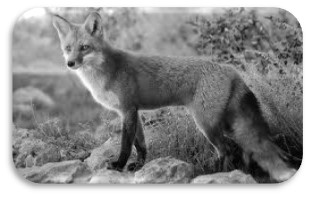
Unearthed by: Kathy Arscott!
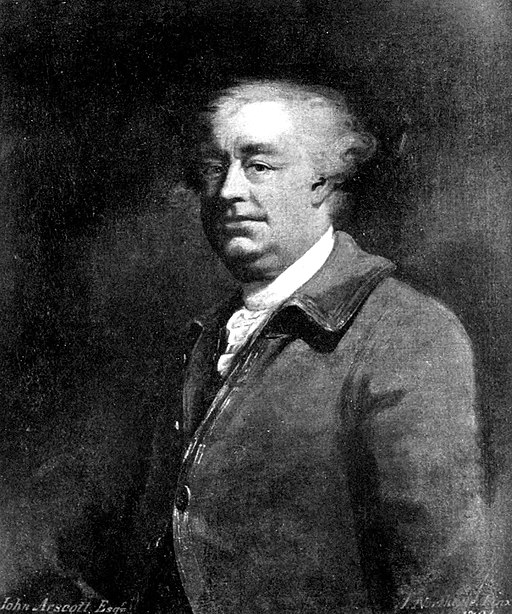
John Arscott
From the picture by y. Northcote. R.A.
Public domain, via Wikimedia Commons
The family of Arscott of Dunsland is one of the most ancient in the county. Its certified pedigree goes back to 1300, when they were Arscotts of Arscott, in the parish of Holsworthy.
The elder branch remained at Dunsland, one of the finest houses in North Devon, or rather cluster of houses, for it consists of the early mansion of the reign, at latest, of Henry VII, probably much earlier, of another portion erected in the reign of James I, and of a stately more modern mansion erected in the seventeenth century. Dunsland came into the possession of the Arscotts through John Arscott marriage with the heiress of Battyn in 1522.
In 1634 the heiress of Arscott married William Bickford and it remained in the Bickford family till 1790, when the heiress conveyed it to her husband, William Holland Coham. In 1827 the heiress of Coham conveyed Arscott and Dunsland to her husband, Captain Harvey Dickenson of the Madras Army. whose son, Arscott Harvey Dickinson sold Dunsland in 1945. It was later purchased by the National Trust who had hoped to open it to the public in 1968.
Unfortunately, in November 1967 it was ravaged by fire - nothing was saved or salvaged. Today you can wander through the old parkland and the remaining buildings of the house. The Granary near the Carriage Collection and Stables at Arlington Court, is the granary from Dunsland House.

The Dunsland Granary at Arlington Court
37
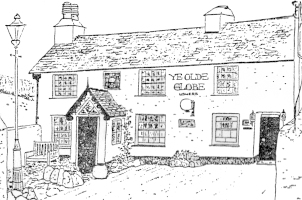
NEWS FROM THE GLOBE & SAWMILL INN
The Globe
- Food is served daily 12.00-2.00 p.m. and 6.00-9.00 p.m. On Saturdays and Sundays, the bar is open all afternoon.
- Open MIC Nights - every Sunday 9.00 p.m. during August. Dates for the winter to be confirmed.
- Thursday, 18th August: Exmoor Borderline & Red Petticoats will dance on the front car park [weather permitting!] at 8.00 p.m.
- Fortnightly Quiz Nights resume on Sunday, 4th September, 8.30 p.m.
* Gluten Free Diets: Some of our home-made meals are now available without gluten/wheat - please ask a member of staff which meals are suitable for a gluten free diet.
The Sawmill Inn
- August: open daily from 12.00 noon. Food - 1.00 to 4.00 p.m. and 5.00 to 9.00 p.m.
- September: food available at lunchtimes and evenings, times to be confirmed. Every Thursday in August: 'Slack Alice' from 9.00 p.m.
- New for 2011 - Bar Billiards: come along and have a go at this good old pub game.
** Both pubs now have a £6.00 Lunch Menu [different at each pub]**
38
CROSSWORD ANSWERS
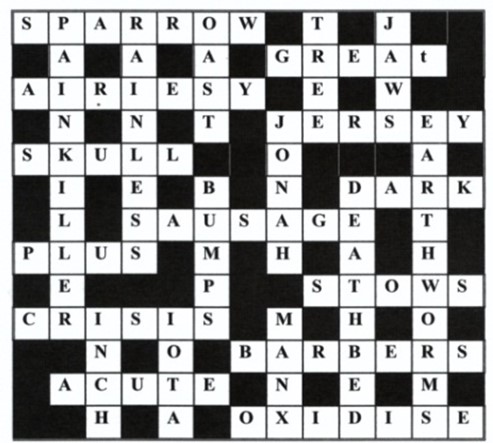
39
AT-A-GLANCE DIARY
| AUGUST | |
| 9th | Combe Martin Museum: Coffee Morning Parish Council Meeting, Penn Curzon Room 7.00 p.m. |
| 10th | Combe Martin Museum: Seashore Safari, 9.00 a.m. Mobile Library in Village from 10.45 a.m. |
| 13th | Coffee Morning - Canine Partners, Manor Hall, 10.00 - 12.00 noon |
| 16th | Combe Martin Museum: Seashore Safari, 1.30 p.m. St. Peter's Church: Summer Fayre, Manor Hall, 6.30 p.m. |
| 18th | The Globe: Exmoor Borderline and Red Petticoats, 8.00 p.m. |
| 19th | Horticultural & Craft Show: Entries to Manor Hall 7.00 - 8.30 p.m. |
| 20th | Horticultural & Craft Show: Entries to Manor Hall by 10.30 a.m. Show at 2.00 p.m. Pudding Jazz Evening, Sloley Farm, 6.00 p.m. |
| 23rd | Combe Martin Museum: Coffee Morning |
| 24th | Mobile Library in Village from 10.45 a.m. |
| 27th | to 29th inc. St. Peter's Church: Flower Festival |
| 27th | St. Peter's Church: Music Concert, 7.30 p.m. |
| 31st | Friendship Lunch, The Globe, 12.00 noon Combe Martin Museum: Seashore Safari, 1.00 p.m. |
| SEPTEMBER | |
| 5th | Primary School and College: Start of Autumn Term |
| 7th | Pilates Class resumes, 9.00 a.m. Mobile Library in Village from 10.45 a.m. |
| 13th | Parish Council Meeting, Penn Curzon Room, 7.00 p.m. |
| 14th | Pilates Open Coffee Morning, Manor Hall, 10.00 a.m. |
| 21st | Mobile Library in Village from 10.45 a.m. |
| 24th | Macmillan Coffee Event, Combe Martin Community Centre 10-12 and 25th Hospice Walks [see article on page 33] |
| 28th | Friendship Lunch, The Globe, 12.00 noon |
| OCTOBER | |
| 2nd | St. Peter's Church: Harvest Festival Service, 11.00 a.m. |
| 5th | Mobile Library in Village from 10.45 a.m. St. Peter's Church: Harvest Evensong and Supper |
Manor Hall Diary:
| Mondays | Upholstery, 9.00 a.m. to 1.00 p.m. Craft Group, 1.30 p.m. onwards Badminton, 7.30 p.m. |
|---|---|
| Tuesdays | 2nd & 4th in month: N.D.Spinners Yoga, 7.00 p.m. |
| Wednesdays | Pilates Body Workout, 9.00 a.m. |
| Thursdays | Tai Chi, Manor Hall, 11.00 a.m. |
| Fridays | Term time only: Toddlers Soft Play and Activity |
| Penn Curzon Room | Term time only: Monday - Friday
Mornings: Berrynarbor Pre-School
|
Mobile Library:
(Assistant - Jacqui Mackenzie)
| 10.45 - 11.30 a.m. | Village Shop |
|---|---|
| 11.45 - 12.15 p.m. | Sterridge Valley |
40
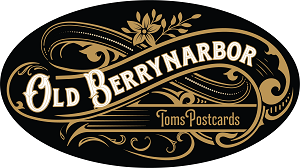
OLD BERRYNARBOR NO. 132
Sea
View, Barton Lane
William Garratt, the Bristol photographer, published this photographic postcard around 1925. Sea View was originally called 'Hills Cottage Tenement' and was listed in the Watermouth Estates Sale of August 1920 as Lot 24. It was sold for £900 with completion on Lady Day, 25th March 1921.
The description stated:
Hills
Cottage Tenement in Barton Lane. A
Highly Desirable SMALL HOLDING, comprising: A Slated Dwelling House,
Outbuildings and about '7a 3r
37p of Pasture and Arable Lands, in the occupation of Mr. W Draper as a
Yearly Lady-day Tenancy, and Mr. W. H. Howard as a Michaelmas Tenant.
There
are some good Building Sites and a good Spring of Water on this Lot. The Apportioned Tithe on this Lot is 16s.6d.

At that time there were no other cottages
or houses on Barton Lane except for Home Barton Farm, and so it is little
wonder that this cottage was renamed 'Sea View'.
Older residents of Berrynarbor will no
doubt remember 'Granny Gray', or Alma Annie nee Huxtable, at Bessemer
Thatch. She was born in this cottage in
1888 which at that time belonged to her grandparents. Her parents, John and Alma Huxtable, moved
to Middle Cockhill in 1890, when she was just two years old, and had a small
market garden. In the same sale of
1920, her parents purchased Middle Cockhill for £750 as Lot No. 18. William Huxtable was a thatcher and made and
repaired thatched roofs as well as 'cobs' for bees and worked with reeds in
covering corn 'mows' [small stacks of corn].
He was the village expert on bees and if ever a hive split up, he would
be called upon to collect and move the swarm from a hedge or wall into one of his
cobs, and would then either sell them or keep them.
Sadly, Granny Gray's father John was a
cripple, but he managed the small holding and like his father became the
village expert on bees and carried out thatching in spite of his disability,
living right into his '80's.
My thanks to Gary Songhurst who replied to
my request in my previous article on Watermouth Harbour. He informs me that the sailing boat in the
left hand picture was the 'Hydra', one of the last Bristol Channel Pilot Cutters
owned by Tom Bidgood.


The boat in the second picture was 'The
Curlew', built and made of mahogany for Alan Wickendon who at the time owned
Watermouth Castle and Harbour. Gary
recalls that the wall on which the boy is standing was the old breakwater, and
shortly after Gary's father designed and he helped to extend the breakwater for
the Wickendon's. They used old railway
sleepers from the Ilfracombe line, some of which were made from mahogany! The smaller boats behind The Curlew were
owned by the Darch family from Combe Martin and 'Pride of Devon' by Claude
Parkin.
Tom
Bartlett
Tower
Cottage, July 2011
e-mail: tomandinge40@gmail.com
41
FAREWELL

We are taking this opportunity to say farewell to friends and acquaintances of Berrynarbor and Combe Martin.
We have been very privileged to have been able to live in such a beautiful area and will very much miss it. We have moved to Stourport-on-Severn, Worcestershire where the terrain is a little flatter and we shall be a bit nearer the family.
We send our love and best wishes to you all.
Joan and Malcolm Garbett
42
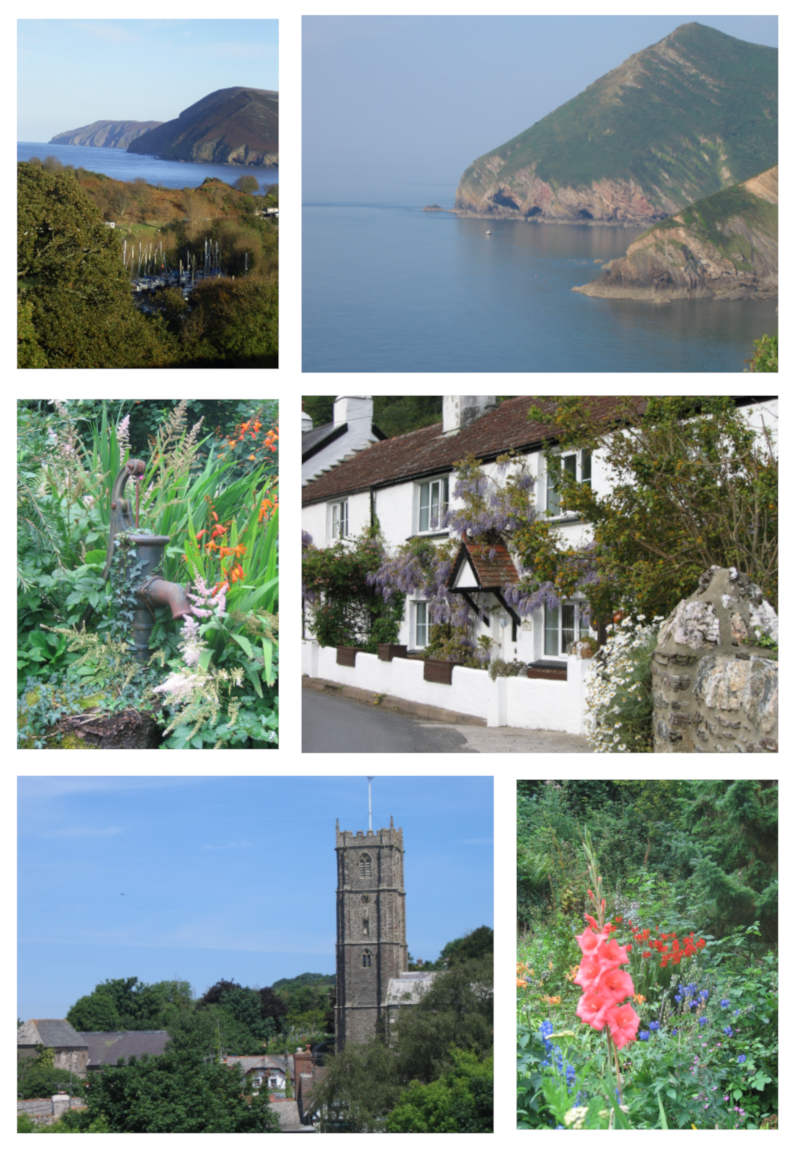
Photographs by: Judie Weedon
43

Photographs by: Judie Weedon
44
